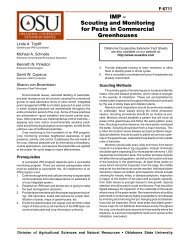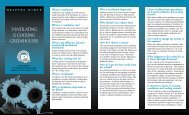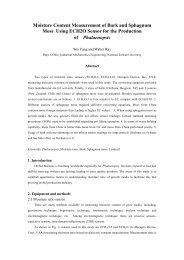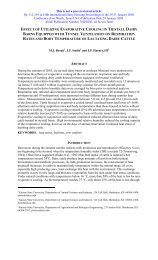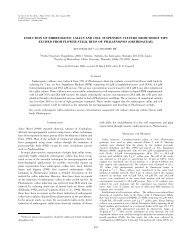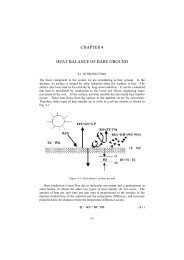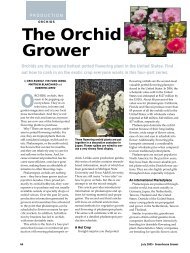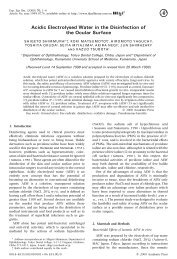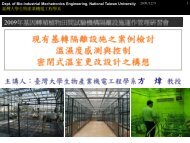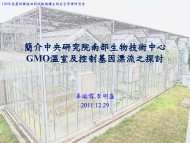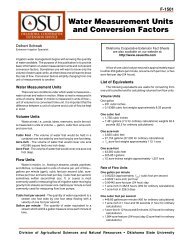Review on thermal energy storage with phase change: materials ...
Review on thermal energy storage with phase change: materials ...
Review on thermal energy storage with phase change: materials ...
- No tags were found...
Create successful ePaper yourself
Turn your PDF publications into a flip-book with our unique Google optimized e-Paper software.
Table 5Organic eutectics <strong>with</strong> potential use as PCMCompoundMelting temperature(°C)B. Zalba et al. / Applied Thermal Engineering 23 (2003) 251–283 261Heat of fusi<strong>on</strong>(kJ/kg)Thermal c<strong>on</strong>ductivity(W/m K)37.5% Urea þ 63:5% acetamide 53 [1] n.a. n.a. n.a.67.1% Naphthalene þ67 [11] 123.4 [11] 0.136 (liquid, 78.5 °C) [11] n.a.32:9% benzoic acid0.130 (liquid, 100 °C) [11]0.282 (solid, 38 °C) [11]0.257 (solid, 52 °C) [11]% in weight; n.a.: not available.Density(kg/m 3 )<strong>on</strong> observati<strong>on</strong> over experimental set-ups [78,79]. Porisini [80] tested the corrosi<strong>on</strong> of four commerciallyavailable salt hydrates used as PCMs in 1988. Recently, Cabeza et al. [81–84] studiedcorrosi<strong>on</strong> resistance of five comm<strong>on</strong> metals (aluminium, brass, copper, steel and stainless steel) inc<strong>on</strong>tact <strong>with</strong> molten salt hydrates (zinc nitrate hexahydrate, sodium hydrogen phosphate dodecahydrate,calcium chloride hexahydrate, sodium carb<strong>on</strong>ate, potassium hydrogen carb<strong>on</strong>ate,potassium chloride, water, sodium acetate trihydrate, and sodium thiosulphate pentahydrate) inan immersi<strong>on</strong> corrosi<strong>on</strong> test.Some investigati<strong>on</strong>s have been c<strong>on</strong>cerned <strong>with</strong> corrosi<strong>on</strong> of molten salts at high temperature.Already in 1980, Heine et al. [21] studied the corrosi<strong>on</strong> performance of six molten salts meltingbetween 235 and 857 °C vs. four metals used at these temperatures.2.3.3. Encapsulati<strong>on</strong> of the <strong>materials</strong>The encapsulati<strong>on</strong> of the PCM has developed interest in several researchers. Advantages anddisadvantages of different geometries of PCM encapsulati<strong>on</strong> <strong>with</strong> different <strong>materials</strong> and theircompatibility was discussed by Lane [3]. The freezing and melting processes of water c<strong>on</strong>tained inspherical elements was studied experimentally by Eames et al. [85], proposing semi empiricalequati<strong>on</strong>s that allow the mass of ice <strong>with</strong>in a sphere to be predicted at any time during the freezingor melting processes. Earlier, Bedecarrats et al. [86,87] and All<strong>on</strong>cle [88], studied the crystallizati<strong>on</strong>process of an organic eutectic in a spherical encapsulati<strong>on</strong>.For the use of PCM in buildings applicati<strong>on</strong>s, an encapsulati<strong>on</strong> of PCM (50–80%) <strong>with</strong>unsaturated polyester matrix (45–10%), and water (5–10%) was studied by Morikama et al.[89]. Polymerisati<strong>on</strong> of PCMs has been also studied for other applicati<strong>on</strong>s, like insulati<strong>on</strong><strong>materials</strong> for use in clothing or bedding articles [90]. In the same area, Inaba [91] and Lee andChoi [92] propose using the <strong>storage</strong> substance integrated <strong>with</strong> the building <strong>materials</strong> <strong>with</strong>outencapsulati<strong>on</strong> (‘‘Shape-stabilised paraffin’’: 74% paraffin þ 26% high-density polyethylene(HDPE)). Structural stability is achieved using HDPE which retains the paraffin when in liquid<strong>phase</strong>.Revankar et al. studied the presence of c<strong>on</strong>centrated voids in encapsulated PCM use for spacebasedheat ex<strong>change</strong>rs [93].For many applicati<strong>on</strong>s, PCMs are microencapsulated, and this has been studied by severalresearchers [94] and developed by companies like BASF[95]. Nevertheless, the potential use ofmicroencapsulated PCMs in various <strong>thermal</strong> c<strong>on</strong>trol applicati<strong>on</strong>s is limited to some extent by



